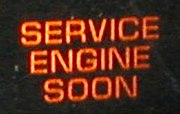

This article has multiple issues. Please help improve it or discuss these issues on the talk page. (Learn how and when to remove these template messages)
|




Acheck engine lightormalfunction indicator lamp (MIL), is a tell-tale that a computerized engine-management system used to indicate a malfunction or problem with the vehicle ranging from minor (such as a loose gas cap) to serious (worn spark plugs, engine problems or a faulty oil valve, etc.). Found on the instrument panel of most automobiles, it usually bears the legend engine,[1] check engine, service engine soon, maintenance required, emiss maint,[2] or a pictogram of an engine—and when illuminated, it is typically an amber or red color.
The light generally[3] has two stages: steady (indicating a minor repairable fault, but service on the vehicle is strongly recommended as soon as possible to prevent future damage) and flashing (indicating a severe fault and an emergency that makes the vehicle unsafe to drive and it is strongly recommended that the vehicle gets mechanical attention straight away). When the MIL is lit, the engine control unit stores a fault code related to the malfunction, which can be retrieved—although in many models this requires the use of a scan tool. This warning light can indicate almost anything from a loose gas cap to a serious knock or fault in the engine.[4]
In the United States, specific functions are required of the MIL by EPA regulations.[5]
Some older vehicles had a single indicator labeled "trouble" or "engine"; this was not an MIL, but an "idiot light" meant to indicate serious trouble with the engine (low oil pressure, overheating, or charging system problems) and an imminent breakdown. This usage of the "engine" light was discontinued in the mid-1980s, to prevent confusion with the MIL.
The MIL appeared in the early 80s along with computerized engine controls. Even the earliest systems, such as General Motors' CCC (computer command control) system had self diagnosis functionality. When the computer detected a fault, it illuminated the MIL. Up until OBDII, on most cars the MIL could output codes. When two pins on the ALDL are jumped, the light would flash the codes, for instance (blink) (pause) (blink) (blink) for code 12. Some manufacturers, such as Honda, retained this feature even after OBDII.
The MIL is commonly referred to today as the "check engine light" or the "service engine soon light".[6][7][8]
Some vehicles manufactured from the late 1990s to mid 2000s have a MIL that illuminates based on the odometer reading, regardless of engine operation. For example, in several Mazda models, the light will come on at 80,000 miles (130,000 km) and remain lit without generating a computer trouble code.[citation needed] Volvo had a light labeled "lambda", lambda sond being another name for oxygen sensor. This was done in order to remind the driver to change the oxygen sensor. Some American-built 1973–1976 Chrysler Corporation vehicles had a similar odometer-triggered reminder: "Check EGR", which was reset after service at a Chrysler dealership.
The MIL is also illuminated prior to starting the engine, along with other tell-tales on the dashboard, to demonstrate that the lamp is working and not burned out. The lamp will turn off once the car is started if no monitored faults exist. The MIL will also illuminate if the engine has been cranked but failed to start after returning the ignition to "on". In most modern vehicles this is usually due to not giving the engine enough cranking time to start. In pre-fuel injection years many cranking attempts were sometimes required to start the car. If the engine fails to start on the second or third attempt then an actual visual check of the engine could be required. If the engine suddenly stalls or is triggered by an overload, such as on a manual transmission car, the MIL will also illuminate until the engine is started again.
Higher amounts of methanol/ethanol (or other additives) than the engine is equipped to handle may trigger the MIL (see E85). These burn differently from gasoline, and the EFI system may mistakenly interpret the oxygen sensor's readings as being incorrect. Oxygenated gasoline can cause this false triggering in early EFI systems.[citation needed]
|
Car interior
| |
|---|---|
Part of a series of articles on cars | |
| Instruments |
|
| Controls |
|
| Anti-theft |
|
|
|
|
| Other elements |
|
| Convenience |
|
| |